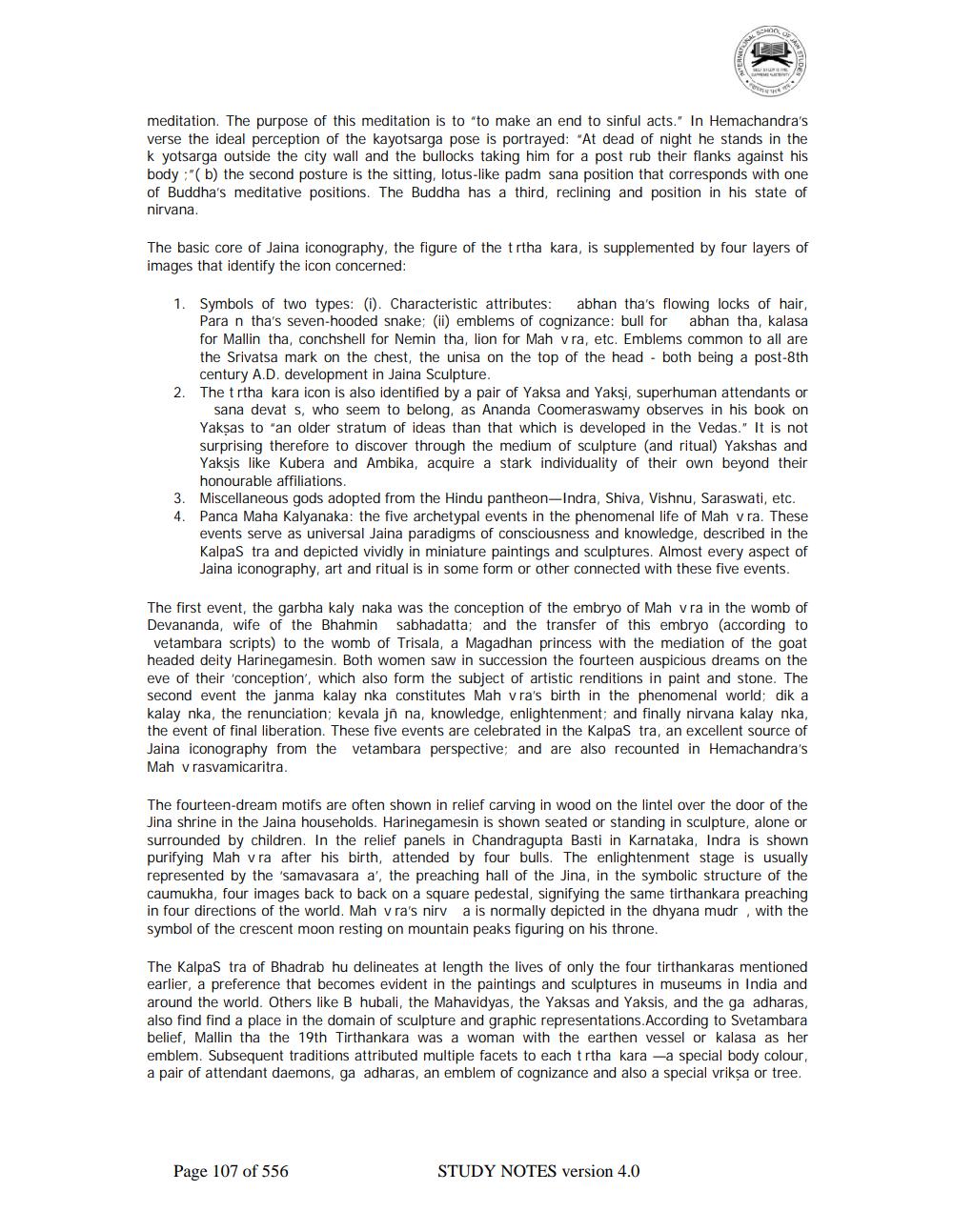________________
meditation. The purpose of this meditation is to "to make an end to sinful acts." In Hemachandra's verse the ideal perception of the kayotsarga pose is portrayed: "At dead of night he stands in the k yotsarga outside the city wall and the bullocks taking him for a post rub their flanks against his body:"(b) the second posture is the sitting, lotus-like padm sana position that corresponds with one of Buddha's meditative positions. The Buddha has a third, reclining and position in his state of nirvana.
The basic core of Jaina iconography, the figure of the trtha kara, is supplemented by four layers of images that identify the icon concerned:
1. Symbols of two types: (i). Characteristic attributes: abhan tha's flowing locks of hair,
Para n tha's seven-hooded snake; (ii) emblems of cognizance: bull for abhan tha, kalasa for Mallin tha, conchshell for Nemin tha, lion for Mah vra, etc. Emblems common to all are the Srivatsa mark on the chest, the unisa on the top of the head - both being a post-8th
century A.D. development in Jaina Sculpture. 2. The trtha kara icon is also identified by a pair of Yaksa and Yaksi, superhuman attendants or
sana devat s, who seem to belong, as Ananda Coomeraswamy observes in his book on Yakşas to "an older stratum of ideas than that which is developed in the Vedas." It is not surprising therefore to discover through the medium of sculpture (and ritual) Yakshas and Yaksis like Kubera and Ambika, acquire a stark individuality of their own beyond their
honourable affiliations. 3. Miscellaneous gods adopted from the Hindu pantheon-Indra, Shiva, Vishnu, Saraswati, etc. 4. Panca Maha Kalyanaka: the five archetypal events in the phenomenal life of Mah v ra. These
events serve as universal Jaina paradigms of consciousness and knowledge, described in the KalpaS tra and depicted vividly in miniature paintings and sculptures. Almost every aspect of Jaina iconography, art and ritual is in some form or other connected with these five events.
The first event, the garbha kaly naka was the conception of the embryo of Mah vra in the womb of Devananda, wife of the Bhahmin sabhadatta; and the transfer of this embryo (according to
vetambara scripts) to the womb of Trisala, a Magadhan princess with the mediation of the goat headed deity Harinegamesin. Both women saw in succession the fourteen auspicious dreams on the eve of their conception', which also form the subject of artistic renditions in paint and stone. The second event the janma kalay nka constitutes Mah vra's birth in the phenomenal world; dik a kalay nka, the renunciation; kevala jn na, knowledge, enlightenment; and finally nirvana kalay nka, the event of final liberation. These five events are celebrated in the Kalpas tra, an excellent source of Jaina iconography from the vetambara perspective; and are also recounted in Hemachandra's Mah v rasvamicaritra.
The fourteen-dream motifs are often shown in relief carving in wood on the lintel over the door of the Jina shrine in the Jaina households. Harinegamesin is shown seated or standing in sculpture, alone or surrounded by children. In the relief panels in Chandragupta Basti in Karnataka, Indra is shown purifying Mah vra after his birth, attended by four bulls. The enlightenment stage is usually represented by the 'samavasara a', the preaching hall of the Jina, in the symbolic structure of the caumukha, four images back to back on a square pedestal, signifying the same tirthankara preaching in four directions of the world. Mah v ra's nirva is normally depicted in the dhyana mudr, with the symbol of the crescent moon resting on mountain peaks figuring on his throne.
The KalpaS tra of Bhadrab hu delineates at length the lives of only the four tirthankaras mentioned earlier, a preference that becomes evident in the paintings and sculptures in museums in India and around the world. Others like B hubali, the Mahavidyas, the Yaksas and Yaksis, and the ga adharas, also find find a place in the domain of sculpture and graphic representations. According to Svetambara belief, Mallin tha the 19th Tirthankara was a woman with the earthen vessel or kalasa as her emblem. Subsequent traditions attributed multiple facets to each trtha kara -a special body colour, a pair of attendant daemons, ga adharas, an emblem of cognizance and also a special vriksa or tree.
Page 107 of 556
STUDY NOTES version 4.0




